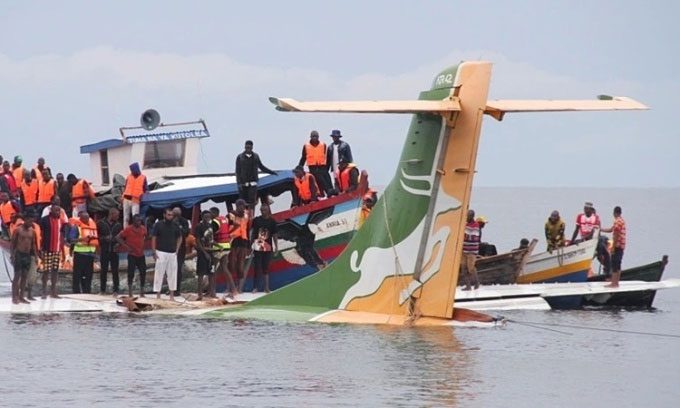One critical mistake passengers can make when a plane must land on water is inflating their life vests too early.
Dave Inch, the captain of a Boeing 787, shared essential steps for passengers to take in case of an emergency landing. In the event of a water landing, it is crucial not to inflate your life vest until you reach the emergency exit.

Rescue teams recover the Precision Air passenger plane that crashed into Lake Victoria in Bukoba, Tanzania, on November 6. (Photo: Reuters).
If you inflate your life vest too soon, water will flood the cabin, pushing trapped passengers against the ceiling or leaving them suspended in the water. Passengers may find themselves either trapped in the cabin or unable to escape quickly, leading to potentially dire consequences. In such cases, it is essential to remove your life vest as quickly as possible. Once at the exit, hold onto another person wearing a life vest to help you get out. This emergency gear can support two people floating at once.
According to Humans for Survival, a committee of experts focused on global risk solutions, there are specific steps passengers should follow if this situation arises.
- First, do not panic. Stay calm and focused when the emergency occurs. This will help you think clearly and make decisions that could save your life.
- Second, quickly locate the emergency exit. Look around for the nearest exit and make your way out as swiftly as possible before the plane sinks.
- Third, signal for help once you are out of the plane and floating safely by wearing your life vest or holding onto something. The most crucial thing is to stay afloat to await rescue. Staying afloat can be challenging, especially if you are injured during evacuation. However, it is vital for your survival.
As reported by Insider, air travel remains the safest form of public transportation worldwide. Nonetheless, it is advisable for passengers to pay close attention to the safety instructions provided by flight attendants before takeoff. These instructions can sometimes be the key to survival.
On November 6, a Precision Air aircraft crashed into Lake Victoria while attempting to land at an airport in Bukoba, northwest Tanzania, resulting in 19 fatalities. This incident marks the latest emergency water landing in the aviation industry.
The most famous emergency water landing in aviation history is known as the “Miracle on the Hudson.” On January 15, 2009, an Airbus A320 operated by US Airways took off from LaGuardia Airport in New York. The plane, carrying 150 passengers and five crew members, was en route to Charlotte, North Carolina. Just minutes after takeoff, the aircraft collided with a flock of birds, forcing the captain to land on the Hudson River. All 155 people on board survived, although some sustained injuries.
Another notable figure associated with a water landing incident is Bahia Bakari, the sole survivor of Yemenia Flight 626. The Airbus A310 crashed into the Indian Ocean in 2009, resulting in the deaths of 152 others. At the time, Bakari was only 13 years old, could not swim, and did not have a life vest. She clung to a piece of debris for over nine hours before being rescued. Bakari’s mother, who was traveling with her, perished in the accident. The media worldwide dubbed Bakari the “miracle girl” for her extraordinary survival.


















































